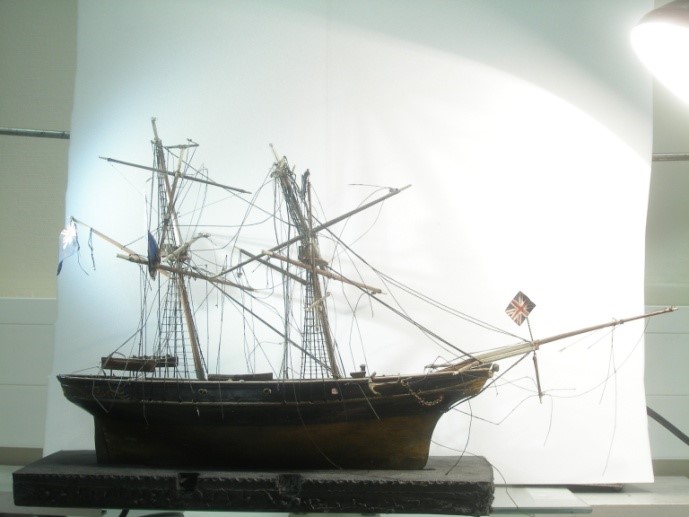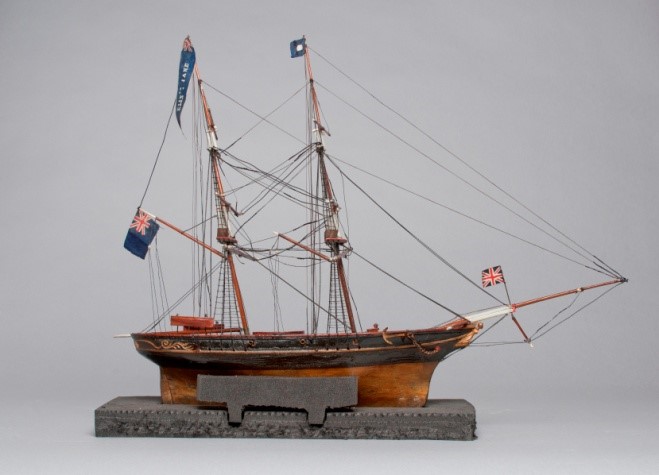Model Ship
Object

Our latest post is looking at a model ship from Beamish Museum which came into the conservation department in 2011. It was originally owned by Darlington Museum but was donated to Beamish in 1993 when the museum closed down. The name of the ship is ‘Elizabeth Jane’.
The model is of a square-rigged two masted ship with yard arms on both sides, which indicates it is a brig. Brigs were purposefully designed to have a raked entry at the bow to ensure they could reach fast speeds but still be manoeuvrable. The ship has room for three sails on each mast, however it appears that this model never had sails attached.
There are four flags on the model ship; the first is a union jack, the second states the name of the ship is the Elizabeth jane, the third is the Blue Peter (white square on a blue background), and the fourth is the blue ensign (blue with a small union jack in the corner). The ship itself is quite small and lightly armed so is unlikely to be a naval vessel but could be a merchant vessel. As there are no sails on the model, it is unlikely to be a toy or a working model, however it could be a reconstruction of a real ship.
Condition
- Evidence of dust and dirt on the surface.
- Physical damage to the masts, fighting tops and rigging.
- Failed adhesive on the flags.
- Surface deterioration to the flags.
- Surface material loss on the hull and keel.
Conservation

An initial clean of the model ship was undertaken using a vacuum and a soft brush in order to remove the loose surface dust and dirt. It became clear during this treatment that several of the fittings on the model ship were loose and to avoid causing accidental damage they were carefully removed. Two of the flags were also removed in order that they could more easily be treated.
Following dry cleaning of the model ship, it was clear that there was still evidence of dirt on the surface and so wet cleaning was implemented using an appropriate solvent that didn’t damage the pigment on the surface. This successfully removed the remaining dirt from the surface and brightened the model ship. Solvent cleaning was also implemented on one of the flags as there were stains on the surface. It was important that only dampened swabs were applied to the surface in order to prevent the textile from becoming too damp.
As there was damage to the model ship’s flags, the decision was made to stabilise them using a backing material. Several options were tested in order to determine the most effective material and the most appropriate adhesive for textiles. The backing material was applied to the damaged areas in order to provide support and stability to the flags. The flags were then reattached using a suitable adhesive rather than stitching in order to avoid further damage to the original stitch holes.

As a number of the masts were damaged, the decision had to be made whether to simply use adhesive, or attempt to dowel them. Dowelling can provide increased stability for joins, however it was determined that there wasn’t enough surface area to work with and so an appropriate adhesive for wood was chosen instead. Once applied, the masts were clamped in place in order to achieve a strong bond while the adhesive cured.
Repairs to the rigging was by far the most time consuming task in this project, and reference books were consulted in order to determine where the rigging was meant to be. As some of the original rigging was still suitable, it was decided that as much of this would be used as possible, and any new rigging would be attached to the old. This was achieved by overlapping the old and new rigging and adhering the two together. As the adhesive used didn’t cure translucent, a small amount of powder pigment was added in order to help blend the old and new rigging and make the repairs less intrusive. Finally, any areas of surface material loss on the hull and keel were inpainted using acrylics in order to minimise the obtrusiveness of the damage.
